Preventing Weld Undercut: Proven Techniques Every Welder Must Know
Wiki Article
Grasping the Art of Welding: Just How to Stay Clear Of Undercut Welding Issues for Flawless Construction Outcomes
Performance and precision are critical on the planet of welding, where also the least imperfection can endanger the architectural integrity of a produced item. One usual obstacle that welders face is damaging, an issue that can lead and deteriorate a weld joint to expensive rework. By recognizing the origin of undercut welding and applying reliable strategies to stop it, welders can raise their craft to brand-new levels of quality (Preventing weld undercut). In the search of remarkable manufacture results, understanding the art of welding to prevent undercut issues is not simply a skill however a need for those pursuing perfection in their job.Comprehending Undercut Welding

To avoid undercut welding, welders should ensure appropriate welding parameters, such as readjusting the existing, voltage, travel rate, and maintaining the appropriate electrode angle. In addition, using the proper welding method for the specific joint arrangement is important. Utilizing weaving motions or backstepping strategies can assist guarantee correct weld steel deposition and reduce the probability of undercut development. Normal inspection of welds throughout and after the welding procedure is likewise essential to catch any undercut early and make needed adjustments to avoid further problems. Preventing weld undercut. By recognizing the reasons of undercut welding and implementing precautionary actions, welders can achieve top quality, structurally audio welds.
Sources Of Undercut in Welding
Recognizing the elements that add to damage in welding is important for welders to create top notch, structurally audio welds. Damaging takes place when the weld steel does not properly load the groove formed in between the base steel and the previously deposited weld metal. Numerous elements can bring about damage in welding. One usual reason is excessive heat input. Welding at heats for extended durations can result in the base metal thawing even more than preferred, causing damage. Insufficient welding current or incorrect welding rate can also add to undercut. Not enough current may not supply enough heat to thaw the base and filler steels effectively, while excessive speed can protect against appropriate combination, creating undercut. Additionally, incorrect electrode angles or incorrect lantern control methods can produce locations of reduced weld steel deposition, promoting undercut. Understanding these reasons and implementing appropriate welding methods can aid avoid undercutting issues, making certain solid and long lasting welds.Strategies to Avoid Undercutting

To reduce the danger of damaging in welding, welders can use tactical welding methods intended at enhancing the top quality and stability of the weld joints. In addition, utilizing the proper welding technique for the details joint configuration, such as weave or stringer beads, can add to reducing undercutting.
In addition, correct joint prep work, including making sure tidy base materials free of impurities and using the ideal welding consumables, is essential in protecting against undercut flaws. Using back-step welding strategies and controlling the weld grain profile can also aid distribute heat equally and lessen the danger of undercut. Normal examination of the weld joint during and after welding, along with carrying out quality control procedures, can aid in spotting and resolving undercutting concerns immediately. By implementing these techniques faithfully, welders can accomplish remarkable construction results with marginal undercut flaws.
Significance of Appropriate Welding Criteria
Selecting and keeping appropriate welding parameters is necessary for attaining successful welds with minimal defects. Welding criteria refer to variables such as voltage, present, take a trip rate, electrode angle, and shielding gas flow price that directly influence the welding procedure. These parameters should be meticulously adjusted based on the kind of product being bonded, its density, and the welding strategy utilized.Correct welding criteria ensure the correct amount of warm is applied to melt the base steels and filler product consistently. If the specifications are established too expensive, it can result in extreme warm input, triggering burn-through, distortion, or spatter. On the other hand, if the specifications are too reduced, incomplete fusion, lack of infiltration, or damaging might occur.
Quality Control in Welding Workflow

Verdict
In conclusion, understanding the art of welding requires a thorough understanding of undercut welding, its reasons, and strategies to stop it. By making sure correct welding specifications and applying top quality guarantee methods, perfect fabrication outcomes can be accomplished. It is crucial for welders to regularly pursue excellence in their welding operations to avoid undercut concerns and produce high-quality welds.Undercut welding, a common defect in welding processes, occurs when the weld steel does not effectively load the groove and leaves a groove or depression along the welded joint.To prevent undercut welding, welders must ensure correct welding parameters, such as adjusting the existing, voltage, traveling rate, and preserving the right electrode angle. Insufficient welding incorrect or current welding speed can additionally contribute best site to undercut.To look at this web-site mitigate the danger of damaging in welding, welders can employ calculated welding techniques aimed at improving the high quality and integrity of the weld joints.In final thought, understanding the art of welding requires a detailed understanding of undercut welding, its causes, and methods to prevent it.
Report this wiki page